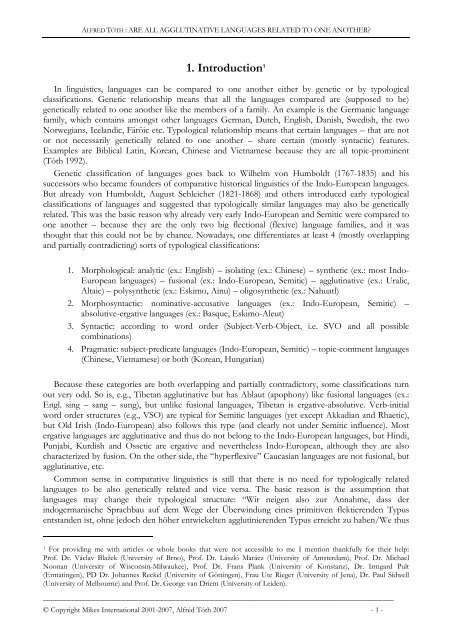Are all agglutinative languages related to one another?
Are all agglutinative languages related to one another?
Are all agglutinative languages related to one another?
You also want an ePaper? Increase the reach of your titles
YUMPU automatically turns print PDFs into web optimized ePapers that Google loves.
ALFRÉD TÓTH : ARE ALL AGGLUTINATIVE LANGUAGES RELATED TO ONE ANOTHER?<br />
1. Introduction 1<br />
In linguistics, <strong>languages</strong> can be compared <strong>to</strong> <strong>one</strong> <strong>another</strong> either by genetic or by typological<br />
classifications. Genetic relationship means that <strong>all</strong> the <strong>languages</strong> compared are (supposed <strong>to</strong> be)<br />
genetic<strong>all</strong>y <strong>related</strong> <strong>to</strong> <strong>one</strong> <strong>another</strong> like the members of a family. An example is the Germanic language<br />
family, which contains amongst other <strong>languages</strong> German, Dutch, English, Danish, Swedish, the two<br />
Norwegians, Icelandic, Färöic etc. Typological relationship means that certain <strong>languages</strong> – that are not<br />
or not necessarily genetic<strong>all</strong>y <strong>related</strong> <strong>to</strong> <strong>one</strong> <strong>another</strong> – share certain (mostly syntactic) features.<br />
Examples are Biblical Latin, Korean, Chinese and Vietnamese because they are <strong>all</strong> <strong>to</strong>pic-prominent<br />
(Tóth 1992).<br />
Genetic classification of <strong>languages</strong> goes back <strong>to</strong> Wilhelm von Humboldt (1767-1835) and his<br />
successors who became founders of comparative his<strong>to</strong>rical linguistics of the Indo-European <strong>languages</strong>.<br />
But already von Humboldt, August Schleicher (1821-1868) and others introduced early typological<br />
classifications of <strong>languages</strong> and suggested that typologic<strong>all</strong>y similar <strong>languages</strong> may also be genetic<strong>all</strong>y<br />
<strong>related</strong>. This was the basic reason why already very early Indo-European and Semitic were compared <strong>to</strong><br />
<strong>one</strong> <strong>another</strong> – because they are the only two big flectional (flexive) language families, and it was<br />
thought that this could not be by chance. Nowadays, <strong>one</strong> differentiates at least 4 (mostly overlapping<br />
and parti<strong>all</strong>y contradicting) sorts of typological classifications:<br />
1. Morphological: analytic (ex.: English) – isolating (ex.: Chinese) – synthetic (ex.: most Indo-<br />
European <strong>languages</strong>) – fusional (ex.: Indo-European, Semitic) – <strong>agglutinative</strong> (ex.: Uralic,<br />
Altaic) – polysynthetic (ex.: Eskimo, Ainu) – oligosynthetic (ex.: Nahuatl)<br />
2. Morphosyntactic: nominative-accusative <strong>languages</strong> (ex.: Indo-European, Semitic) –<br />
absolutive-ergative <strong>languages</strong> (ex.: Basque, Eskimo-Aleut)<br />
3. Syntactic: according <strong>to</strong> word order (Subject-Verb-Object, i.e. SVO and <strong>all</strong> possible<br />
combinations)<br />
4. Pragmatic: subject-predicate <strong>languages</strong> (Indo-European, Semitic) – <strong>to</strong>pic-comment <strong>languages</strong><br />
(Chinese, Vietnamese) or both (Korean, Hungarian)<br />
Because these categories are both overlapping and parti<strong>all</strong>y contradic<strong>to</strong>ry, some classifications turn<br />
out very odd. So is, e.g., Tibetan <strong>agglutinative</strong> but has Ablaut (apophony) like fusional <strong>languages</strong> (ex.:<br />
Engl. sing – sang – sung), but unlike fusional <strong>languages</strong>, Tibetan is ergative-absolutive. Verb-initial<br />
word order structures (e.g., VSO) are typical for Semitic <strong>languages</strong> (yet except Akkadian and Rhaetic),<br />
but Old Irish (Indo-European) also follows this type (and clearly not under Semitic influence). Most<br />
ergative <strong>languages</strong> are <strong>agglutinative</strong> and thus do not belong <strong>to</strong> the Indo-European <strong>languages</strong>, but Hindi,<br />
Punjabi, Kurdish and Ossetic are ergative and nevertheless Indo-European, although they are also<br />
characterized by fusion. On the other side, the “hyperflexive” Caucasian <strong>languages</strong> are not fusional, but<br />
<strong>agglutinative</strong>, etc.<br />
Common sense in comparative linguistics is still that there is no need for typologic<strong>all</strong>y <strong>related</strong><br />
<strong>languages</strong> <strong>to</strong> be also genetic<strong>all</strong>y <strong>related</strong> and vice versa. The basic reason is the assumption that<br />
<strong>languages</strong> may change their typological structure: “Wir neigen also zur Annahme, dass der<br />
indogermanische Sprachbau auf dem Wege der Überwindung eines primitiven flektierenden Typus<br />
entstanden ist, ohne jedoch den höher entwickelten agglutinierenden Typus erreicht zu haben/We thus<br />
1 For providing me with articles or whole books that were not accessible <strong>to</strong> me I mention thankfully for their help:<br />
Prof. Dr. Václav Blažek (University of Brno), Prof. Dr. László Marácz (University of Amsterdam), Prof. Dr. Michael<br />
Noonan (University of Wisconsin-Milwaukee), Prof. Dr. Frans Plank (University of Konstanz), Dr. Irmgard Pult<br />
(Ermatingen), PD Dr. Johannes Reckel (University of Göttingen), Frau Ute Rieger (University of Jena), Dr. Paul Sidwell<br />
(University of Melbourne) and Prof. Dr. George van Driem (University of Leiden).<br />
___________________________________________________________________________________<br />
© Copyright Mikes International 2001-2007, Alfréd Tóth 2007 - 1 -

















